Shaking Table Tests of Seismic Response of Multi-Segment Utility Tunnels in a Layered Liquefiable Site
Abstract
1. Introduction
2. Test Design
2.1. Similarity Ratio Design of the Model Soil-Structure System
2.2. Model Soil and Model Structure
2.3. Types and Layout of Sensors
2.4. Input Motion and Loading Conditions
3. Data Analysis of the Model Soil
3.1. Similarity Ratio Design of the Model Soil-Structure System
3.2. Pore Pressure Characteristics of the Model Soil
3.3. Deformation of the Model Soil
4. Data Analysis of the Model Structure
4.1. Acceleration Response of the Model Structure
4.2. Displacement Characteristics of the Model Structure
4.3. Strain Analysis of the Model Structure
5. Conclusions
- (1)
- When the seismic intensity is small, the acceleration in the soil has an obvious amplification effect, and the amplification factor is greater for shallow soils. As the seismic intensity increases, the sand layer liquefies, the seismic energy is lost, the acceleration in the soil decays, and the liquefied sand layer exhibits a significant seismic isolation effect.
- (2)
- Soil liquefaction is higher at the junction of clay and sand layers. The structure influences the spatial distribution of the pore pressure field, with the structure obstructing the seepage path and the pore pressure growing and dissipating more slowly in the soil beneath it. The growth of pore pressure in liquefied foundations is an accumulation of seismic energy, and the phase of a rapid rise in the Arias intensity curve corresponds to the phase of dramatic growth in the pore water pressure ratio.
- (3)
- During the shaking table test, as the loading stages progressed, water seeped out of the surface of the model soil, cracks formed and developed on the ground surface, significant uplift of the soil above the utility tunnel, and sand boiling was observed locally.
- (4)
- In the liquefaction site, the restraining effect of the surrounding soil on the structure is reduced and the movement of the two is not consistent. The total density of the utility tunnel is relatively low, and the structure is lifted as a whole under the action of excess pore water pressure. There are vertical and horizontal displacement differences between the two sides of the deformation joints, the joints have good waterproof performance, and the deformation joints increase the flexibility of the structure to reduce the structural forces. In the test, the utility tunnel is located at the junction of the clay and sand layers, where bending action dominates the structural deformation. The strain is greatest at the internal partition wall top slab joints, followed by the side wall top slab joints, with the lowest strain at the bottom slab.
Author Contributions
Funding
Institutional Review Board Statement
Informed Consent Statement
Data Availability Statement
Conflicts of Interest
References
- Kang, G.-C.; Tobita, T.; Iai, S. Damage to sewerage systems during the 2004 Earthquake in Niigata-ken Chuetsu, Japan. Eng. Geol. 2013, 164, 230–242. [Google Scholar] [CrossRef]
- Arduino, P.; Ashford, S.A.; Assimaki, D.; Bray, J.D.; Eldridge, T.; Frost, D.; Hashash, Y.M.A.; Hutchinson, T.C.; Johnson, L.A.; Kelson, K.I.; et al. Geo-Engineering Reconnaissance of the 2010 Maule, Chile Earthquake; GEER Association: Ledyard, CT, USA, 2010; pp. 1–347. [Google Scholar]
- Kohji, T.; Shuji, T.; Hiroko, S.; Kota, K. Building damage associated with geotechnical problems in the 2011 Tohoku Pacific Earthquake. Soils Found. 2012, 52, 956–974. [Google Scholar] [CrossRef]
- Susumu, Y.; Kenji, H.; Keisuke, I.; Yoshiki, K. Characteristics of liquefaction in Tokyo Bay area by the 2011 Great East Japan Earthquake. Soils Found. 2012, 52, 793–810. [Google Scholar] [CrossRef]
- Yamaguchi, A.; Mori, T.; Kazama, M.; Yoshida, N. Liquefaction in Tohoku district during the 2011 off the Pacific Coast of Tohoku Earthquake. Soils Found. 2012, 52, 811–829. [Google Scholar] [CrossRef]
- Elgamal, A.; Zeghal, M.; Parra, E. Liquefaction of reclaimed island in Kobe, Japan. J. Geotech. Eng. 1996, 122, 39–49. [Google Scholar] [CrossRef]
- Wang, T.-T.; Kwok, O.-L.A.; Jeng, F.-S. Seismic response of tunnels revealed in two decades following the 1999 Chi-Chi earthquake (Mw 7.6) in Taiwan: A review. Eng. Geol. 2021, 287, 106090. [Google Scholar] [CrossRef]
- Kutter, B.L.; Chou, J.-C.; Travasarou, T. Centrifuge Testing of the Seismic Performance of a Submerged Cut-and-Cover Tunnel in Liquefiable Soil. In Proceedings of the Geotechnical Earthquake Engineering and Soil Dynamics Congress IV, Sacramento, CA, USA, 18–22 May 2008. [Google Scholar] [CrossRef]
- Chou, J.-C.; Kutter, B.L.; Travasarou, T.; Chacko, J. Centrifuge Modeling of Seismically Induced Uplift for the BART Transbay Tube. J. Geotech. Geoenvironmental Eng. 2011, 137, 754–765. [Google Scholar] [CrossRef]
- Wang, R.; Fu, P.; Zhang, J.-M. Finite element model for piles in liquefiable ground. Comput. Geotech. 2016, 72, 1–14. [Google Scholar] [CrossRef]
- Azadi, M.; Hosseini, S.M.M. Analyses of the effect of seismic behavior of shallow tunnels in liquefiable grounds. Tunn. Undergr. Space Technol. 2010, 25, 543–552. [Google Scholar] [CrossRef]
- Chandra, J.; Guéguen, P. Nonlinear Response of Soil–Structure Systems using Dynamic Centrifuge Experiments. J. Earthq. Eng. 2019, 23, 1719–1741. [Google Scholar] [CrossRef]
- Chen, S.; Tang, B.; Zhao, K.; Li, X.; Zhuang, H. Seismic response of irregular underground structures under adverse soil conditions using shaking table tests. Tunn. Undergr. Space Technol. 2020, 95, 103145. [Google Scholar] [CrossRef]
- Tang, B.; Li, X.; Chen, S.; Zhuang, H.; Chen, H.-P. Investigations of seismic response to an irregular-section subway station structure located in a soft clay site. Eng. Struct. 2020, 217, 110799. [Google Scholar] [CrossRef]
- Chen, S.; Tang, B.; Zhuang, H.; Wang, J.; Li, X.; Zhao, K. Experimental investigation of the seismic response of shallow-buried subway station in liquefied soil. Soil Dyn. Earthq. Eng. 2020, 136, 106153. [Google Scholar] [CrossRef]
- An, J.; Tao, L.; Jiang, L.; Yan, H. A shaking table-based experimental study of seismic response of shield-enlarge-dig type’s underground subway station in liquefiable ground. Soil Dyn. Earthq. Eng. 2021, 147, 106621. [Google Scholar] [CrossRef]
- Chen, G.; Chen, S.; Qi, C.; Du, X.; Wang, Z.; Chen, W. Shaking table tests on a three-arch type subway station structure in a liquefiable soil. Bull. Earthq. Eng. 2015, 13, 1675–1701. [Google Scholar] [CrossRef]
- Tao, L.; Ding, P.; Shi, C.; Wu, X.; Wu, S.; Li, S. Shaking table test on seismic response characteristics of prefabricated subway station structure. Tunn. Undergr. Space Technol. 2019, 91, 102994. [Google Scholar] [CrossRef]
- Chian, S.C.; Tokimatsu, K.; Madabhushi, S.P.G. Soil Liquefaction–Induced Uplift of Underground Structures: Physical and Numerical Modeling. J. Geotech. Geoenvironmental Eng. 2014, 140, 04014057. [Google Scholar] [CrossRef]
- Chen, R.R.; Taiebat, M.; Wang, R.; Zhang, J.M. Effects of layered liquefiable deposits on the seismic response of an underground structure. Soil Dyn. Earthq. Eng. 2018, 113, 124–135. [Google Scholar] [CrossRef]
- Mahmoud, A.O.; Hussien, M.N.; Karray, M.; Chekired, M.; Bessette, C.; Jinga, L. Mitigation of liquefaction-induced uplift of underground structures. Comput. Geotech. 2020, 125, 103663. [Google Scholar] [CrossRef]
- Shen, Y.; Zhong, Z.; Li, L.; Du, X.; Hesham El Naggar, M. Seismic response of shield tunnel structure embedded in soil deposit with liquefiable interlayer. Comput. Geotech. 2022, 152, 105015. [Google Scholar] [CrossRef]
- Tian, T.; Yao, A.; Li, Y.; Gong, Y. Seismic Response of Utility Tunnels with Different Burial Depths at the Non-Homogeneous Liquefiable Site. Appl. Sci. 2022, 12, 11767. [Google Scholar] [CrossRef]
- Lu, C.-C.; Hwang, J.-H. Safety assessment for a shield tunnel in a liquefiable deposit using a practical dynamic effective stress analysis. Eng. Fail. Anal. 2019, 102, 369–383. [Google Scholar] [CrossRef]
- Zhao, K.; Wang, Q.; Wu, Q.; Chen, S.; Zhuang, H.; Chen, G. Stability of immersed tunnel in liquefiable seabed under wave loadings. Tunn. Undergr. Space Technol. 2020, 102, 103449. [Google Scholar] [CrossRef]
- Lei, M.; Lin, Y.; Zhou, B.-C. Model test to investigate reasonable reactive artificial boundary in shaking table test with a rigid container. J. Cent. South Univ. 2020, 27, 210–220. [Google Scholar] [CrossRef]
- Domenico, L.; Subhamoy, B.; Fabrizio, S.; Matteo, B. Dynamic response of a geotechnical rigid model container with absorbing boundaries. Soil Dyn. Earthq. Eng. 2015, 69, 46–56. [Google Scholar] [CrossRef]
- Zhao, D. Experimental Study and Numerical Simulation of Seismic Response of Urban Underground Metro Structures. Ph.D. Thesis, Tsinghua University, Beijing, China, 2013. [Google Scholar]
- Kemin, J.; Chengshun, X.; Hesham, M.; Xiaoling, Z.; Xiuli, D.; Pengfei, D.; Chunyi, C. Large-scale shake table testing of pile group-bridge model in inclined liquefiable soils with overlying crusts. Soil Dyn. Earthq. Eng. 2022, 163, 107555. [Google Scholar] [CrossRef]
- Shigeki, U.; Masahiro, K.; Shojiro, K.; Kazuhiro, N.; Kazunari, M. Effect of earthquake ground motions on soil liquefaction. Soils Found. 2012, 52, 830–841. [Google Scholar] [CrossRef]
- Seed, H.B.; Lee, K.L. Liquefaction of saturated sands during cyclic loading. J. Smfd 1966, 92, 105–134. [Google Scholar] [CrossRef]
- Tabatabaiefar, R.; Hamid, S.; Behzad, F.; Bijan, S. Seismic behavior of building frames considering dynamic soil-structure interaction. Int. J. Geomech. 2013, 13, 409–420. [Google Scholar] [CrossRef]
- Mahmoud, A.; Hussien, M.; Karray, M.; Chekired, M.; Bessette, C.; Jinga, L. Failure mechanisms of underground structures during earthquake: An overview. In Proceedings of the 68th Canadian Geotechnical Conference and 7th Canadian Permafrost Conference (Geo-Québec), Quebec City, QC, Canada, 20–23 September 2015. [Google Scholar]
- Wood, J. Earthquake design of rectangular underground structures. Bull. New Zealand Soc. Earthq. Eng. 2007, 40, 1–6. [Google Scholar] [CrossRef]

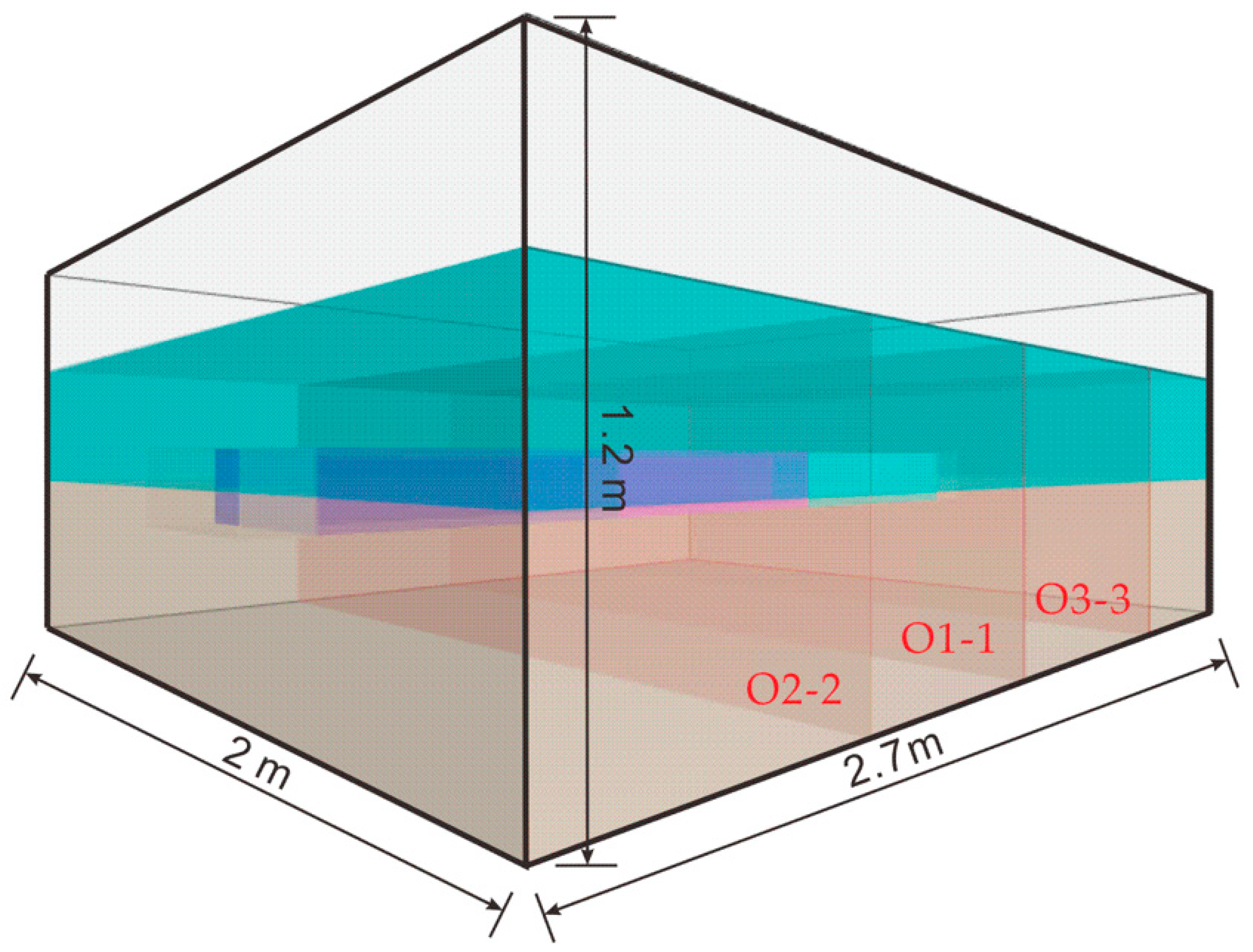
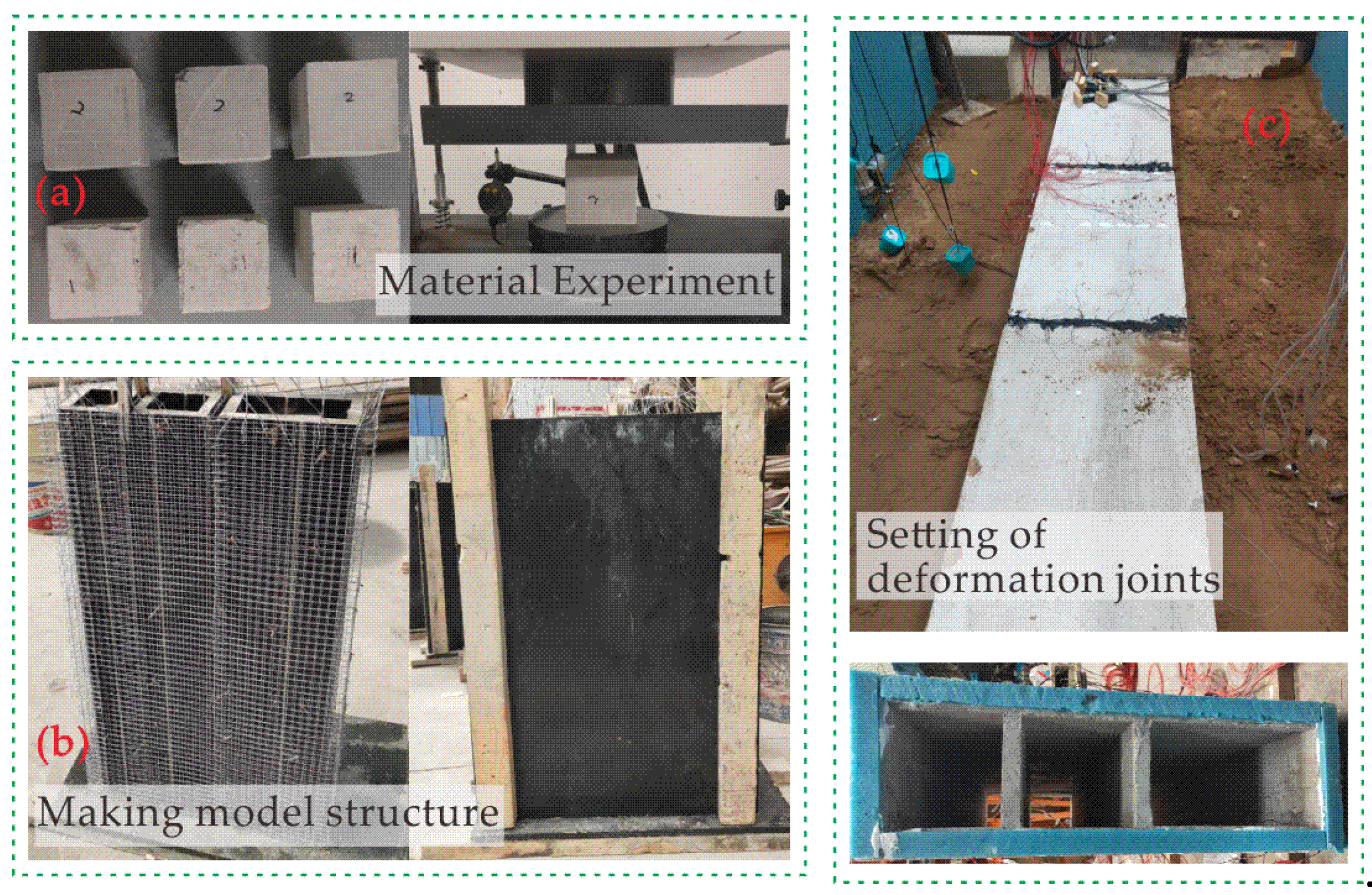
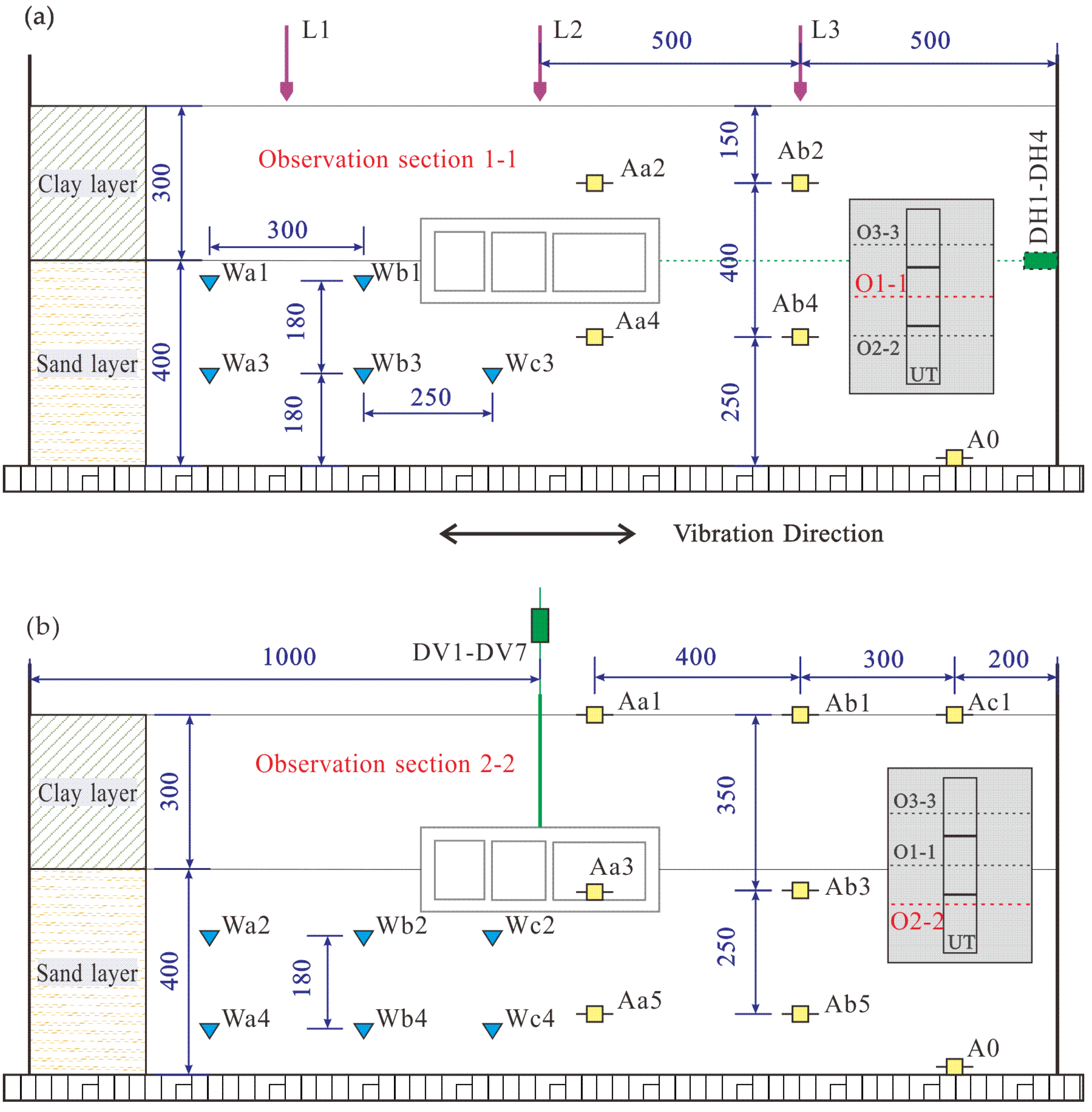

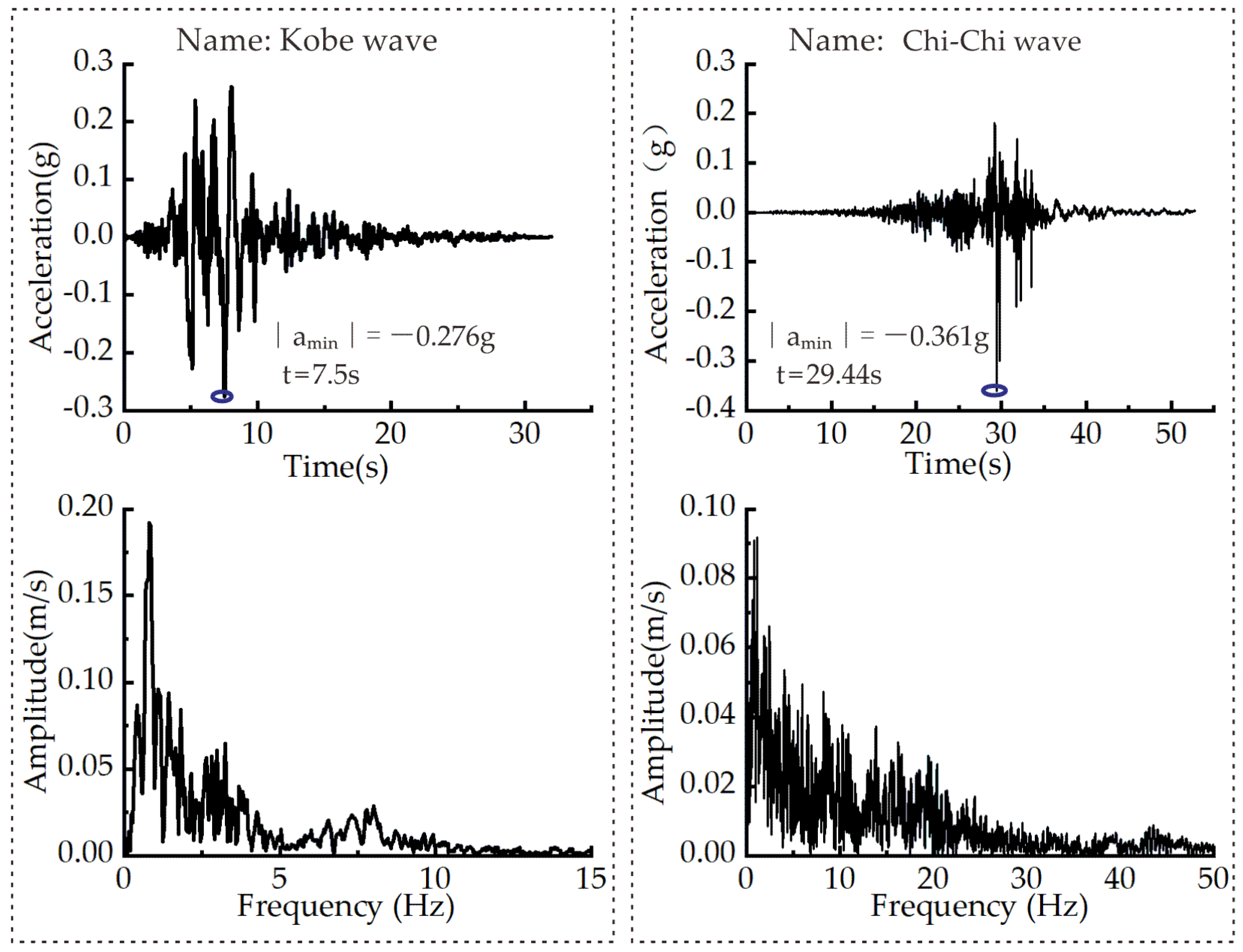

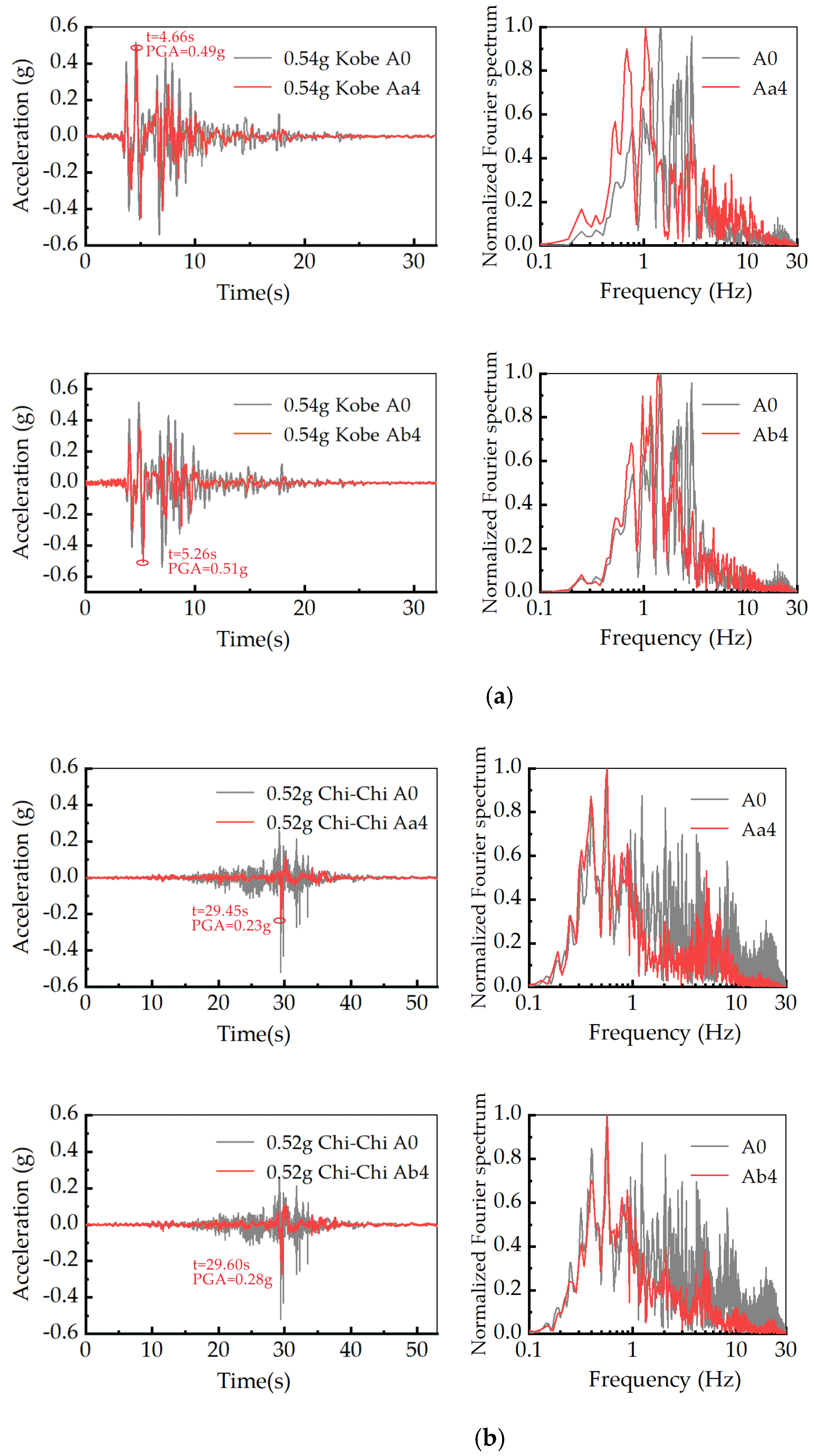
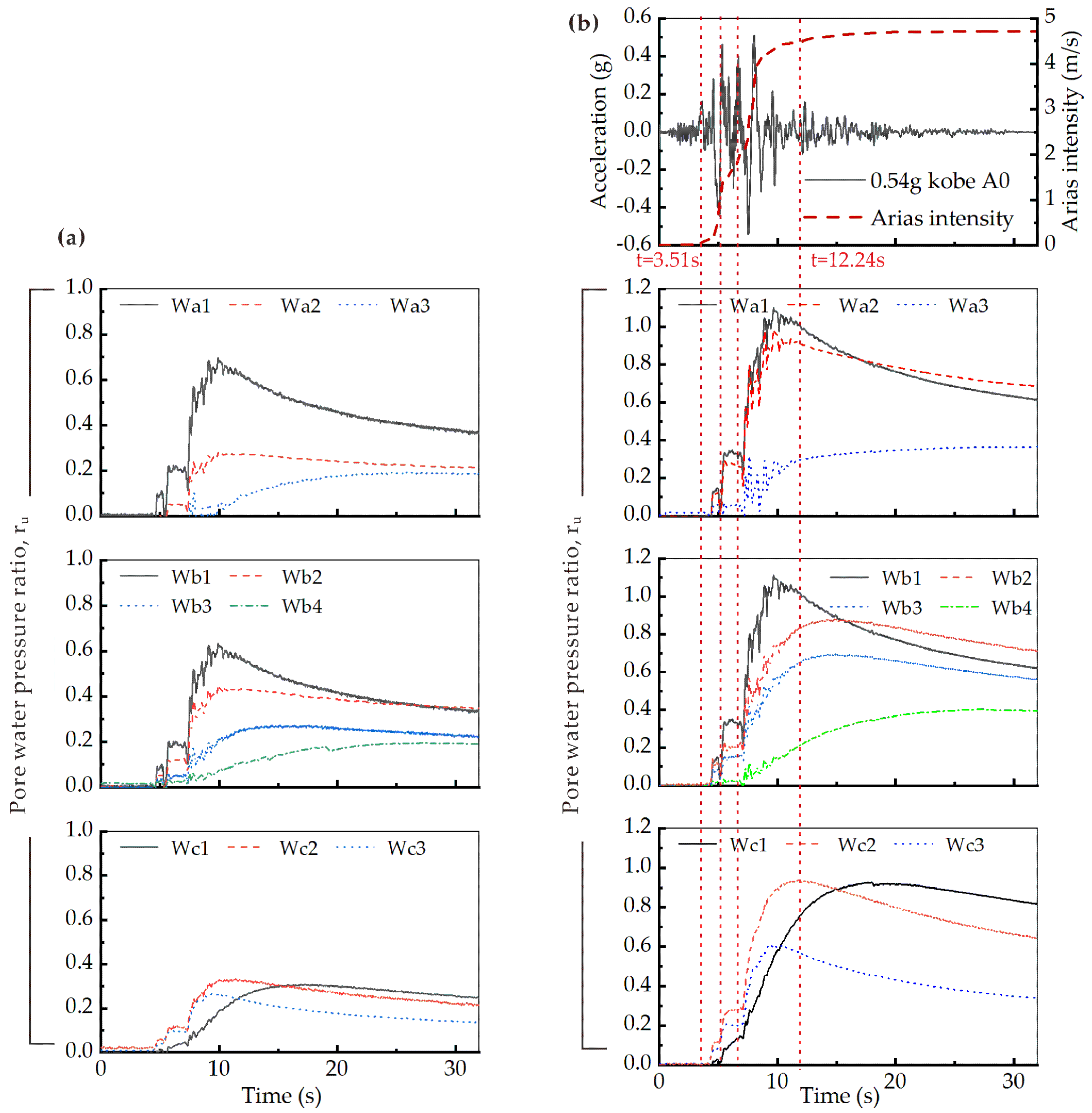
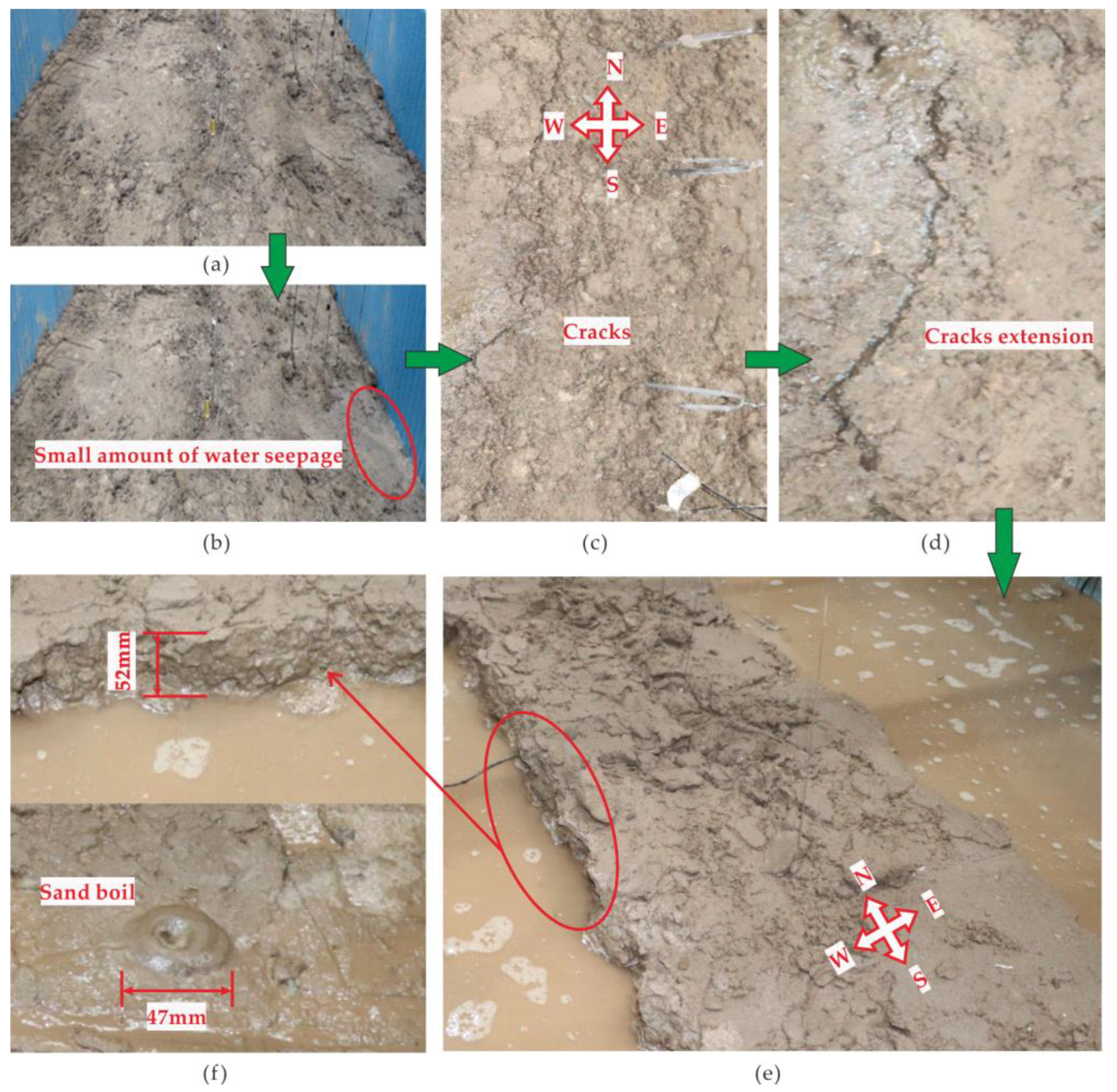
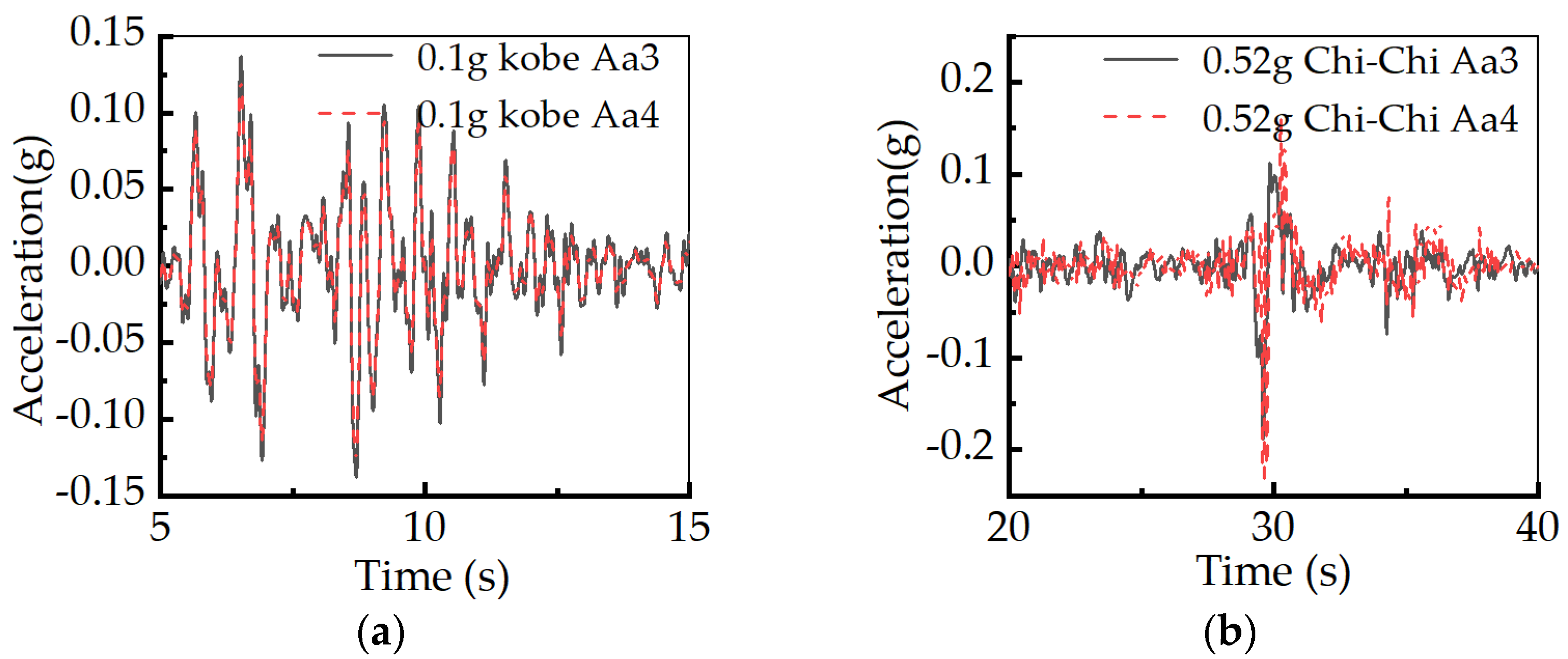
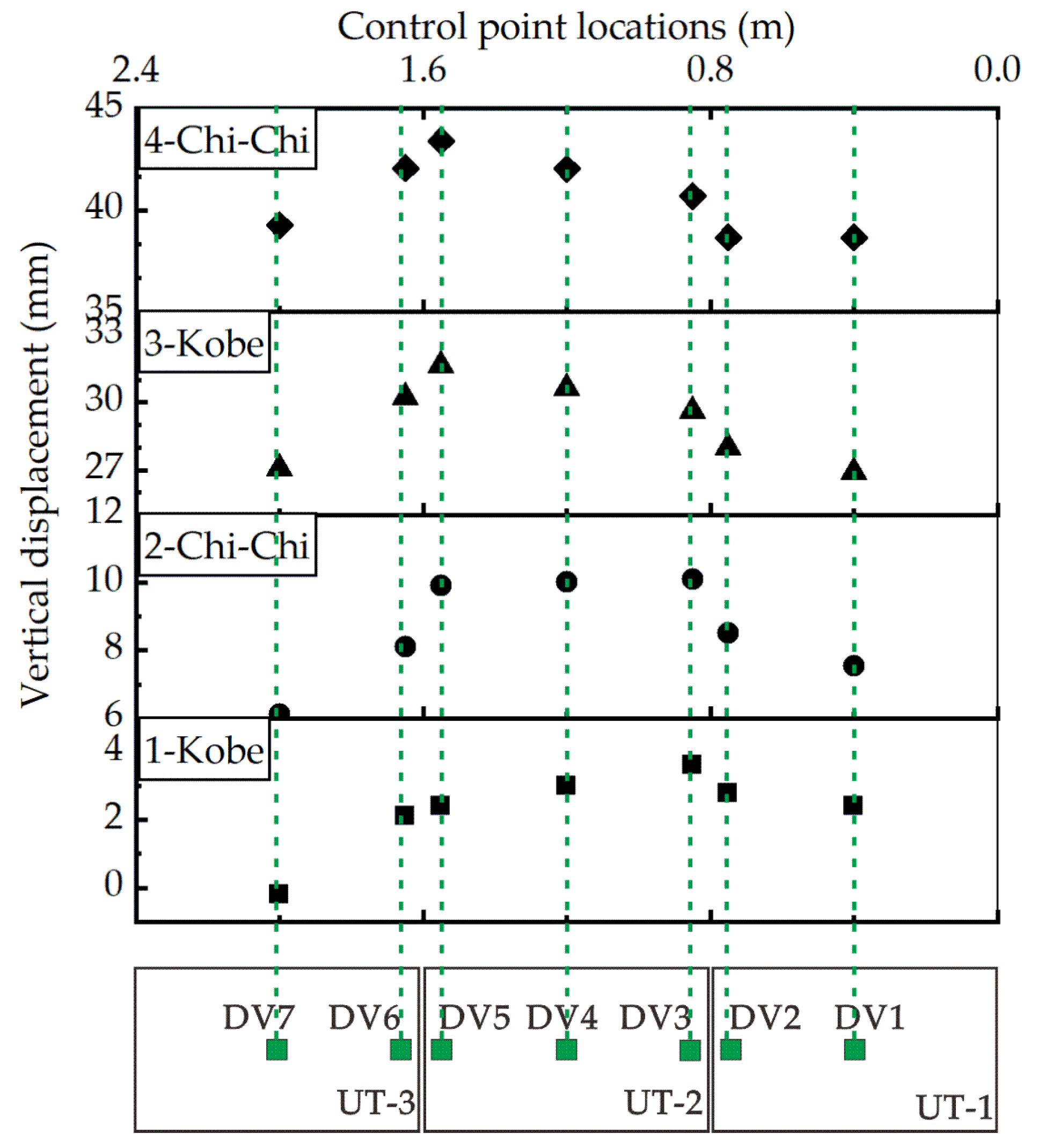
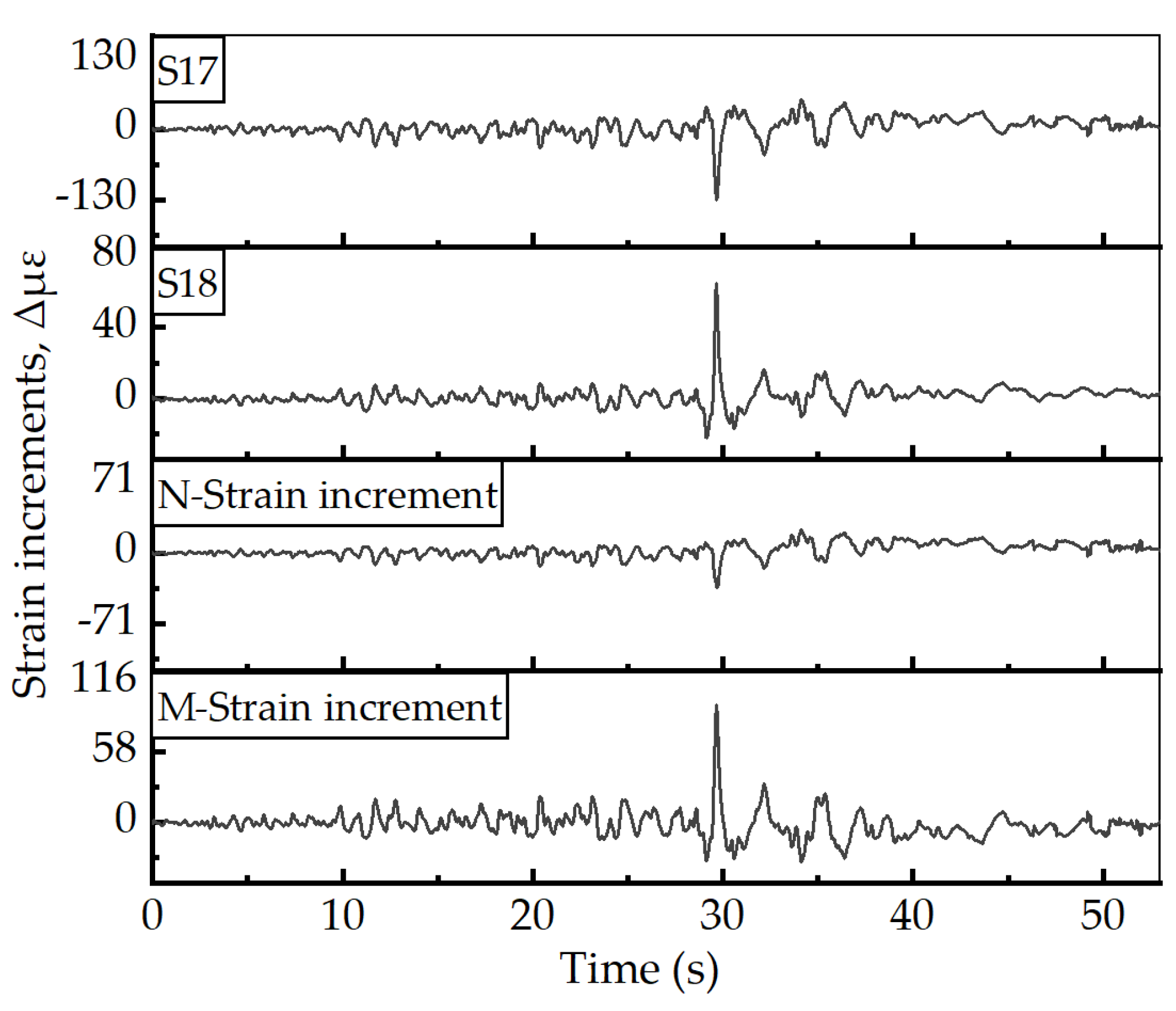
| Type | Physical Quantity | Physical Relationship | Similarity Ratio |
|---|---|---|---|
| Geometric Properties | Length L | SL | 1/25 |
| Moment of Inertia I | SI = SL 4 | 2.56 × 10−6 | |
| Material Properties | Density ρ | Sρ = SE/(SL · Sa) | 5 |
| Elastic modulus E | SE | 1/5 | |
| Mass m | Sm = SL3 · Sρ | 3.20 × 10−4 | |
| Strain ε | Sε = Sσ/SE | 1 | |
| Stress σ | Sσ = Sε · SE | 5 | |
| Shear wave velocity Vs | Sv | 1/2 | |
| Dynamic Properties | Time t | St = SL0.5 · Sa−0.5 | 1/5 |
| Acceleration a | Sa | 1 |
| Case | Input Motion | Code | Target PGA * (g) | Actual PGA (g) |
|---|---|---|---|---|
| 1 | Kobe | 1-Kobe | 0.1 | 0.1 |
| 2 | Chi-Chi | 2-Chi-Chi | 0.1 | 0.09 |
| 3 | Kobe | 3-Kobe | 0.6 | 0.54 |
| 4 | Chi-Chi | 4-Chi-Chi | 0.6 | 0.52 |
| Loading Stages | 1-Kobe Wave | 2-Chi-Chi Wave | 3-Kobe Wave | 4-Chi-Chi Wave |
|---|---|---|---|---|
| Δ1/mm (DH1-DH2) | −0.1 | −5.1375 | −9.4 | −10.8 |
| Δ1/mm (DH3-DH4) | 0.28 | 11.66 | 15.23 | 16.04 |
| Strain Gauge | 1-Kobe Wave | 2-Chi-Chi Wave | 3-Kobe Wave | 4-Chi-Chi Wave | ||||
|---|---|---|---|---|---|---|---|---|
| Peak Value | Residual Value | Peak Value | Residual Value | Peak Value | Residual Value | Peak Value | Residual Value | |
| S15 | 1.05 | −0.36 | 0.98 | 0.51 | 17.35 | 2.41 | 21.14 | 1.55 |
| S18 | 3.33 | 0.30 | 3.78 | 0.86 | 50.84 | 13.19 | 61.56 | 5.43 |
| S22 | 0.73 | 0.38 | 0.67 | 0.01 | 16.32 | 2.99 | 16.43 | 3.89 |
| S19 | 0.66 | −0.48 | 1.17 | 0.47 | 39.60 | 19.10 | 18.07 | 1.88 |
| S20 | 2.93 | 0.28 | 3.48 | 1.20 | 17.68 | 9.44 | 9.70 | 3.60 |
| S3 | 0.60 | −0.45 | 1.50 | 0.26 | 15.66 | 0.89 | 21.19 | 2.03 |
| S12 | 2.15 | 1.31 | 1.46 | 1.37 | 28.98 | 8.71 | 26.00 | 1.26 |
| S9 | 4.09 | 0.26 | 3.54 | 0.26 | 32.69 | 8.97 | 21.46 | 4.26 |
Disclaimer/Publisher’s Note: The statements, opinions and data contained in all publications are solely those of the individual author(s) and contributor(s) and not of MDPI and/or the editor(s). MDPI and/or the editor(s) disclaim responsibility for any injury to people or property resulting from any ideas, methods, instructions or products referred to in the content. |
© 2023 by the authors. Licensee MDPI, Basel, Switzerland. This article is an open access article distributed under the terms and conditions of the Creative Commons Attribution (CC BY) license (https://creativecommons.org/licenses/by/4.0/).
Share and Cite
Yao, A.; Tian, T.; Gong, Y.; Li, H. Shaking Table Tests of Seismic Response of Multi-Segment Utility Tunnels in a Layered Liquefiable Site. Sustainability 2023, 15, 6030. https://doi.org/10.3390/su15076030
Yao A, Tian T, Gong Y, Li H. Shaking Table Tests of Seismic Response of Multi-Segment Utility Tunnels in a Layered Liquefiable Site. Sustainability. 2023; 15(7):6030. https://doi.org/10.3390/su15076030
Chicago/Turabian StyleYao, Aijun, Tian Tian, Yifei Gong, and Hui Li. 2023. "Shaking Table Tests of Seismic Response of Multi-Segment Utility Tunnels in a Layered Liquefiable Site" Sustainability 15, no. 7: 6030. https://doi.org/10.3390/su15076030
APA StyleYao, A., Tian, T., Gong, Y., & Li, H. (2023). Shaking Table Tests of Seismic Response of Multi-Segment Utility Tunnels in a Layered Liquefiable Site. Sustainability, 15(7), 6030. https://doi.org/10.3390/su15076030






